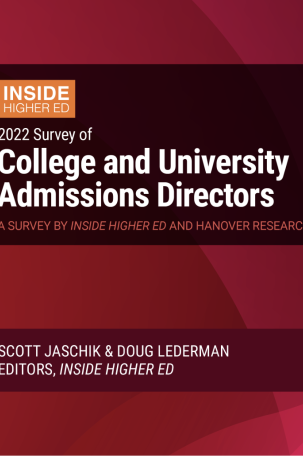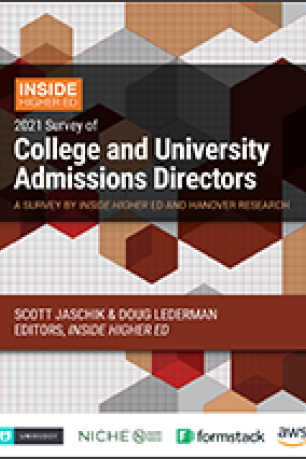Free Download

The 2022 Inside Higher Ed Survey of College and University Admissions Directors arrives at a time of significant change for admissions, with more change coming soon: The Supreme Court will hear two cases involving affirmative action next month. Standardized testing’s importance in admissions is greatly diminished due to the pandemic (and the potential of the Supreme Court to rule against affirmative action). And a new way of doing admissions, in which students provide a portfolio but don’t actually apply to colleges, is gaining favor among the majority of colleges that are not competitive in traditional admissions.
At the same time, most colleges continue with their efforts to build their classes, going after groups of students they want. And colleges continue to recover from the COVID-19 pandemic.
Key findings of the 2022 survey, which had 271 respondents, are:
- Only 36 percent of admissions officers report that their institution met its student enrollment goals this year prior to May 1.
- A little fewer than half of admissions officers expect their enrollment to be higher in the fall of 2022 than it was in fall of 2021. Only about one-fourth of admissions officers expect it to be lower.
- Only about one-fourth of admissions officers report that the coronavirus pandemic did not change which students they admitted.
- Fewer than one-tenth of admissions officers report that they require applicants to submit ACT or SAT scores. A little fewer than half were test optional or test blind before the pandemic, and the other half changed their application process and are now test optional or test blind.
- Of admissions officers whose institutions changed to test-optional or test-blind admissions, most want their college to remain test optional or test blind permanently.
- Fewer than a fourth of respondents had a favorable reaction to the new portfolios that could replace traditional admissions.
- While nearly half of admissions officers prefer that the Supreme Court rules in support of affirmative action plans at Harvard University and the University of North Carolina at Chapel Hill (and nearly half said that they don’t know), half believe that the court will rule against them.
- One-fourth of institutions have reviewed their affirmative action policies, but few have changed them.
Affirmative Action
The issue of affirmative action has periodically reached the Supreme Court in the past, dating to the Bakke decision, in 1978, and Grutter v. Bollinger (2003), in which the Supreme Court upheld the affirmative action plan of the University of Michigan law school. Notably, then Supreme Court Justice Sandra Day O’Connor expressed the view that the court “expects that 25 years from now, the use of racial preferences will no longer be necessary to further the interest approved today.”
More About the Survey
Inside Higher Ed’s 2022 Survey of College and University Admissions Officers was conducted in conjunction with researchers from Hanover Research. Inside Higher Ed regularly surveys key higher ed professionals on a range of topics.
All answers are anonymous.
You may download a full survey report here.
On Wednesday, Oct. 19 at 2 p.m. Eastern, Inside Higher Ed will present a free webcast to discuss the results of the survey. Sign up here.
The Inside Higher Ed survey of admissions directors was made possible in part by support from Niche, CampusReel and Motimatic.
Past surveys by Inside Higher Ed of admissions directors have found overwhelming support for affirmative action in college admissions.
This year’s survey found support continues to be strong, but with doubts on what the court will do. Only 10 percent of the admissions directors expect the Supreme Court to rule in favor of affirmative action.
And in terms of how colleges are getting ready for a possible Supreme Court decision against affirmative action, the 2022 survey found that institutions are not making dramatic changes.
Reactions to the survey results varied.
Shirley J. Wilcher, executive director of the American Association for Access, Equity and Diversity, said via email, “We will not speculate on what the Supreme Court may do. The court may surprise us, as it has before. Moreover, it is not really a question of ’winning or losing.’ There are many possible outcomes, as earlier decisions, e.g., Bakke and Grutter, have shown.”
Edward Blum, president of Students for Fair Admissions, which is suing Harvard and UNC in the two cases before the Supreme Court, said, “It is befuddling and disappointing that, after nearly eight years of litigation, so few admissions offices are prepared to end racial and ethnic classifications and preferences if the Supreme Court rules these polarizing practices are unconstitutional. This suggests that admissions officers did not take Justice O’Connor’s 25-year time limit for race preferences seriously.”
Changes in What Is Asked of Students
The affirmative action cases have also contributed (along with COVID-19, to be sure) to the massive growth of the test-optional movement. While colleges cited the pandemic in making their decisions, many said (privately) that they also were starting to think about the affirmative action cases.
Only 7 percent of admissions officers report that they require applicants to submit ACT or SAT scores. Forty-three percent of admissions officers reported that their institution was test optional or test blind before the pandemic, and 50 percent said they have changed their application process and are now test optional or test blind.
Of those who reported that their policies changed during the pandemic, 54 percent said they saw an increase in applications from Black, Latino and Native American students. And 58 percent admitted more Black, Latino and Native American students.
Forty-seven percent of that group said they admitted more students who needed financial aid to enroll. But only 37 percent of those in that group said that officials at their college “express concerns about the increase in the percentage of students who needed financial aid to enroll.”
Of those who have recently switched to test-optional policies, 67 percent strongly support and 22 percent somewhat support “remaining test-optional or test-blind permanently.”
Equity concerns also are prompting some college admissions officers (and high school counselors) to advocate for fewer students taking Advanced Placement calculus and more of them taking other advanced mathematics courses in high school, such as statistics. They believe that most students would benefit more from other courses, and they note that high schools with many Black and Latino students are less likely to offer calculus than are high schools with lots of white and Asian students.
College admissions directors are divided on this question of discouraging calculus: 13 percent strongly support and 21 percent support the idea; 3 percent strongly oppose the idea, and 7 percent somewhat oppose the idea. A majority (55 percent) said they neither favor nor oppose the idea.
A similar split can be found on letters of recommendation. Most four-year colleges require them for admission, but some say they favor wealthy, white students because those students generally attend public and private high schools where teachers have the time to focus on them, and so some admissions directors want colleges to eliminate them from the admissions process.
Sixteen percent of respondents to the survey strongly favor the idea of ending their use, and 21 percent somewhat support the idea. Nine percent strongly oppose the idea, and 20 percent somewhat oppose the idea. More than a third (34 percent) neither favor nor oppose the idea.
Legacy Admissions
In the last year, legacy admissions preferences—which help students whose parents or other relatives have attended the college they are applying to—have attracted more criticism. The primary criticism is about equity. While members of any ethnic or racial group can be a legacy, legacies overwhelmingly favor white, wealthy applicants. With recent decisions by Johns Hopkins University and Amherst College to end legacy admissions, some have predicted many other colleges would follow. To date, they haven’t.
Thirteen percent of admissions officers said that they favored legacies in some way. Admissions leaders from private institutions (20 percent) are more likely than those at public institutions (3 percent) to report that their institution grants some degree of preference to legacy applicants. (At some public institutions, some count legacies as in-state applicants when they are from out of state.)
But support for legacy admissions (among those who responded to the survey) is minimal over all. Asked to respond to the statement “Institutions should grant some degree of preference to legacy applicants over non-legacy applicants,” only 1 percent strongly agreed, and 11 percent somewhat agreed. Fourteen percent strongly disagreed, and 27 percent somewhat disagreed.
Admissions in a New Way
One of the biggest changes in admissions is the creation of a new way for colleges to admit students—without the students having ever applied to the college. The students create a portfolio with their grades and courses and whatever else they want to show their capabilities. Companies recruit colleges to look at the portfolios and invite some students to enroll. Some colleges operate the system by themselves, and the Common Application and the state of Minnesota have programs. Colleges that are very competitive in admissions have not embraced this system, but dozens of other colleges are now involved.
Inside Higher Ed posed a question about the new approach. But at the time the survey was fielded, only one article had appeared in Inside Higher Ed about the concept. The results:
The numbers expressing support for this new admissions system may seem relatively small (fewer than a quarter of respondents), but this is the first year that supporters of this new approach to admissions have really been visible and active. And assuming that colleges with competitive admissions aren’t advocating for such a switch, the figures may be impressive.
Joe Morrison, the CEO of Concourse, one of the companies in the space, said he thought the results were “very promising.”
The system now being offered by Concourse and others simply makes more sense for many students, especially those from low-income families, he said. Colleges naturally want to know more about any applicant, he said, “but by asking too much, you are creating barriers.”
A Tough Year
This year continued trends of recent years, with relatively few colleges filling their classes by May 1 (or even July 1). However, there are some signs of (modest) improvement.
Only 36 percent of colleges in the survey had filled their classes by May 1, the traditional date by which students respond to admissions offers. Last year, the figure was 32 percent.
Inside Higher Ed also asks about filling the class by two later dates. Of the 174 colleges that hadn’t met their goals for the class by May 1, 17 percent had met the goals by June 1. And of the 144 colleges that still hadn’t met their goals by June 1, 10 percent said they had done so by July 1.
Twenty percent said they would probably admit students next year who wouldn’t have been admitted in the past.
In terms of this year’s classes, 26 percent said they expected a class that was smaller than they had admitted last year, 31 percent said it would be the same, and 43 percent said they expected more students to enroll.
Of those who expected a decline, most expected small declines: 43 percent expected it to be less than 5 percent, and 34 percent said they expected it to be from 5 percent to less than 10 percent.
Goals for Next Year
One question is about goals for next year. Minority students and full-time undergraduate are the top priorities.







